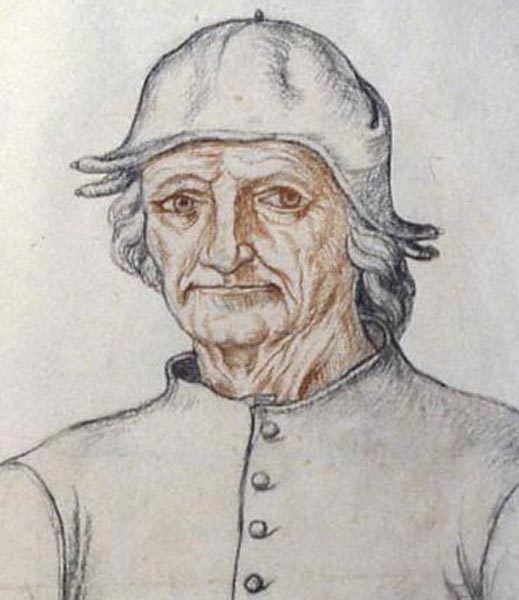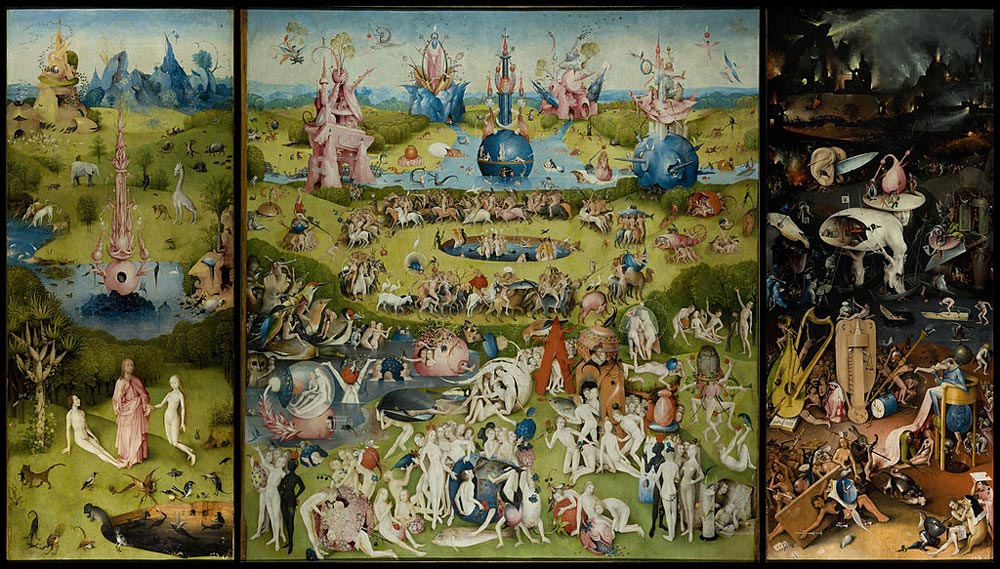| Hieronymus Bosch | |
|---|---|
 |
|
| Born | Jheronimus van Aken c. 1450 ‘s-Hertogenbosch, Duchy of Brabant (Netherlands) |
| Died | Buried on Aug. 9, 1516 |
| Nationality | Dutch |
| Movement | Early Netherlandish Renaissance |
| Field | Painting |
| Works | View Complete Works The Garden of Earthly Delights The Temptation of St. Anthony |
Hieronymus Bosch, sometimes referred to as Jerome Bosch, was a Medieval, Dutch painter, whose work is recognized for his use of vivid imagery which illustrates moral and religious concepts. He also produced some of the first autonomous sketches of Northern Europe. His work produced several triptychs, or panels painted with illustrative messages, one of which is The Garden of Earthly Delights. His paintings often referred to astrology, folklore, witchcraft, a theme of the Antichrist, and saints, with all interwoven into Christian iconography.
A Sketchy Past
Very little is known about the artist’s life, beliefs, or philosophy. What information historians do have, is taken from brief references of Hieronymus from municipal records of that time. The ambiguity begins with his own name. Born Jheronimus van Aken, or Jeroen Anthoniszoon van Aken, it is thought that he used the name Bosch, in reference to his birthplace of Hertogenbosch, commonly called Den Bosch. It was a very small town in Denmark, near the Belgium border. It is also assumed that Hieronymus was chosen in honor of the patron Saint Hieronymus (St. Jerome).
Bosch was a member of a highly-respected conservative religious group called the Brotherhood of Our Lady, and some accounts of his ventures are taken from books of this local order. He was born of a painting family. Jan van Aken, his grandfather, was an artist, and his father became an advisor of art, to the Brotherhood of Our Lady. Between 1479 and 1481, he married into a wealthy family, and the couple moved to Oirschot, a nearby town, where a house and land awaited them.
Artistic Style
 Bosch’s paintings were depictions of a humanity which is sinful. He used a very uniquely free style of painting, unlike the traditional Flemish style. His use of vivid imagery and symbolism possibly reflects the anxieties of his time, and his concern for a changing world. He worked in a manner which is called alla prima. This is direct painting, used mostly with oil paints where layers of paint are applied to previous layers, before the paint dries, so that the art is painted all at once. He was influenced by Dutch manuscript paintings, and foreign prints, as well as social degradation of the time.
Bosch’s paintings were depictions of a humanity which is sinful. He used a very uniquely free style of painting, unlike the traditional Flemish style. His use of vivid imagery and symbolism possibly reflects the anxieties of his time, and his concern for a changing world. He worked in a manner which is called alla prima. This is direct painting, used mostly with oil paints where layers of paint are applied to previous layers, before the paint dries, so that the art is painted all at once. He was influenced by Dutch manuscript paintings, and foreign prints, as well as social degradation of the time.
The most widely known triptychs Bosch produced was The Garden of Earthly Delights. Depicted on the left panel, is Adam, Eve, and many animals. In the center panel, the earthly delights, or nude figures are portrayed with birds and fruits, and on the right panel, are the sinners being punished in various manners. When the right and left panels are closed, God creating Earth is portrayed to the viewer. It is painted somewhat like a sketch, with Bosch’s unique style of drawing with his brush.
The World through Hieronymus Bosch’s Paintings
Hieronymus lived at a time of great turbulence in Western Europe. There was a great discontent with the Roman Catholic church, because many believed the clergy to be morally corrupt. Epidemics plagued the people and killed thousands. It was not unusual to see public hangings, beheadings, and burnings. Because most people were illiterate at this time, art was used to communicate moral messages to the people.
Bosch used monsters and devils as warnings of premonitions of the Last Judgment predicted for the year 1500. He used visual translations of verbal metaphors, explaining moral narratives. It is generally accepted that his art was to teach spiritual truths, and moral principles. Bosch seem to use imagery as visions of dealing with the torments of hell if committing sin.
Ambiguous Interpretations of Paintings
Scholars have varied interpretations of Bosch’s works. Some say they are to amuse, others debate that they are anti-Christian, but most generally, they are revered as moral teachings through illustration. Any interpretation is very subjective, since Bosch’s original titles of artwork did not survive, and since very little is known about him as a person.
Hieronymus signed seven works, which was very unique for that time period. A total of twenty-five, can actually be attributed to him, and others are either by him, or imitators of his work. In the late 16th century, Philip II of Spain received many of Bosch’s paintings, and they are now in the Prado Museum, in Madrid, Spain such as The Seven Deadly Sins and The Last Four Things, The Adoration of the Magi, The Garden of Earthly Delights, and The Stone Operation.